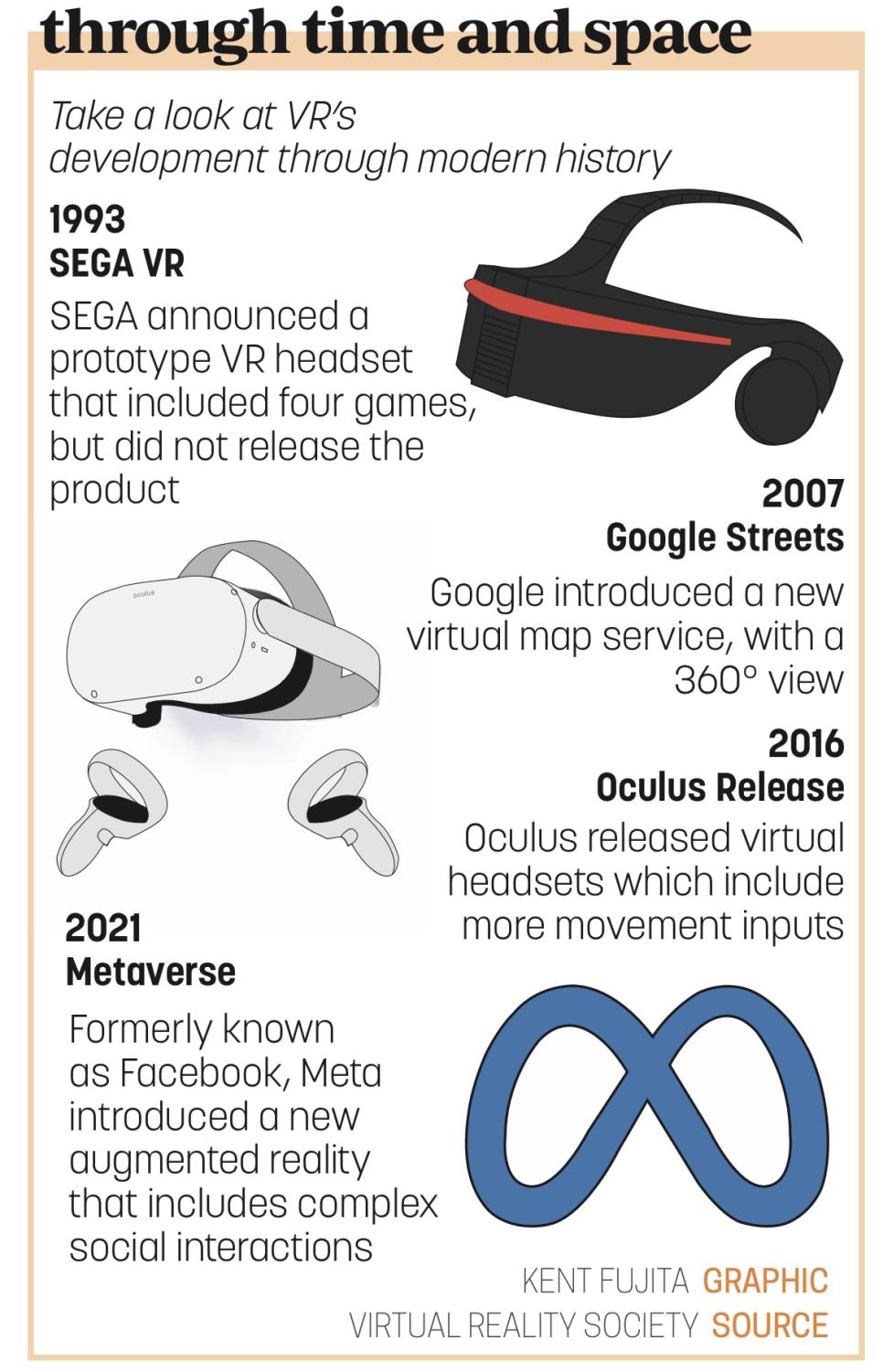Virtual reality (VR) has been failing to capture its full potential, according to an article from ABC News. Still, Facebook, which acquired the VR startup Oculus in 2014, announced in October that it would change its name to Meta, releasing various ads and promotional materials about the Metaverse, a VR and augmented reality platform for business, fitness and education as well as entertainment. Though Meta is betting on the success of VR, eSports director Dylan Gentilcore said VR has two problems it must confront first before it becomes mainstream.
“The first thing is cost,” he said. “The VR headsets themselves can be incredibly expensive, especially if you’re looking for a really dedicated gaming experience. You want a high refresh rate, you want it to be comfortable with a good setup.”
He said though headsets like the Oculus Quest – a cheaper, portable alternative to headsets that require a high end PC – exist they don’t have the power to play more high end games like Valve’s “Half Life: Alyx’’ or VR ports of Bethesda’s “Fallout 4.”
Even so, the Oculus Quest has driven VR’s growth in recent years, with Meta announcing that the Quest 2, retailing at $300, had outsold all of its predecessors combined since its launch.
 Harrison Carter, eSports member and junior said the low price and portability of the Quest is what helped him gain an interest in VR which helped him connect with a friend who had moved.
Harrison Carter, eSports member and junior said the low price and portability of the Quest is what helped him gain an interest in VR which helped him connect with a friend who had moved.
“One of my best friends used to live in South Carolina. Now he lives in Lafayette, but I used to live in South Carolina and when he moved away we weren’t in contact that much,” Carter said. VR made it so we could (breach) the distance and we could have the illusion of being right next to each other and it makes for these personal connections that you can make with friends online.
Jack Cappaert, eSports member and sophomore, who also uses an Oculus Quest, said the draw for him was the release of new games such as “Five Nights at Freddy’s: Help Wanted.” He said that part of what made VR unique was the immersiveness of it.
“For action games it feels like you’re more there as opposed to just watching it from a static screen,” he said.
Carter said he agreed that VR gaming was more immersive than non-VR gaming, though that came with its downsides.
“There are a bunch of videos that see people get too immersed and they jump in the game and they jump in real life,” he said. “ I saw a video of someone jumping into a TV and they broke the TV.”
While playing a game, Carter said he accidentally punched his own mini-fridge.
“I was throwing the Frisbee and my controller hit the mini-fridge. It actually cracked the controller; it’s fine though,” he said.
Gentilcore said another aspect hindering the growth of VR was the lack of sustainable experiences non-VR gaming provides, comparing big games like “Beat Saber” to party games.
“Something like ‘Super Hot,’ even though it’s not a rhythm game, sort of plays out like a rhythm game, so it’s more of these games that test your reactions,” he said. “Test your reactions, test your ability to (match) the rhythm. They’re fun little experiences but they don’t offer that sustained, multi-hour you exploring this world, which I think is what’s going to draw people in more than ever before.”
Gentilcore said games like “Half Life: Alyx,” the long awaited continuation to the popular “Half Life’’ series, differed from other VR games in that it offered an experience with greater depth.
“There’s a narrative built into it,” he said. “There’s a deep experience. It’s not just you doing one repetitive task over and over, but it’s a variety of gameplay challenges for you. There’s gunplay in that game. There’s a lot of puzzle-solving relating to physics, and there are exploration elements that exist.”
Carter, who has played the game, said he agreed.
“‘Half Life,’ being one of the first really big story games (series) of all time, it gets some of the older crowd into it; it gets some of the newer crowd into it just because it’s VR.”

Even so, according to an article from Forbes, “Half Life: Alyx” failed to capture the interest of mainstream audiences, with “Animal Crossing: New Horizons” and “Doom Eternal” faring better in sales. Cappaert said though he had seen VR grow in recent years, the pace has definitely slowed.
Carter said he still likes the immersive experiences that VR can provide and that he is interested in the concept of the Metaverse.
“I really like the idea of being able to create a place where you can go just to experience whatever you want and I think it’s a very modern way of looking at things, it’s very future proof,” he said.
However, Gentilcore said he wasn’t as confident in the Metaverse, saying he couldn’t see VR getting such widespread adoption as becoming an integrated part of people’s daily lives, be it through business or socialization, as Meta hopes it does.
“I don’t know if we’re going to get to that level of adoption where it’s just, ‘Okay, now you can have your professional calls on your headset and use it for ‘Beat Saber,’’ he said. “You’re going to have to see more engaging experiences from an entertainment perspective. We’re going to have to see the cost of that experience be driven down so that for two, three, four hundred bucks you can get a quality headset and not have to pay $500 to $1,000 for the headset and then all of this equipment on top of it.”




























![Keep the New Gloves: Fighter Safety Is Non-Negotiable [opinion]](https://hilite.org/wp-content/uploads/2024/12/ufcglovescolumncover-1200x471.png)
















































![Review: “We Live in Time” leaves you wanting more [MUSE]](https://hilite.org/wp-content/uploads/2024/12/IMG_6358.jpg)
![Review: The premise of "Culinary Class Wars" is refreshingly unique and deserving of more attention [MUSE]](https://hilite.org/wp-content/uploads/2024/12/MUSE-class-wars-cover-2.png)
![Introducing: "The Muses Who Stole Christmas," a collection of reviews for you to follow through winter [MUSE]](https://hilite.org/wp-content/uploads/2024/12/winter-muse-4.gif)
![Review: "Meet Me Next Christmas" is a cheesy and predictable watch, but it was worth every minute [MUSE]](https://hilite.org/wp-content/uploads/2024/11/AAAAQVfRG2gwEuLhXTGm3856HuX2MTNs31Ok7fGgIVCoZbyeugVs1F4DZs-DgP0XadTDrnXHlbQo4DerjRXand9H1JKPM06cENmLl2RsINud2DMqIHzpXFS2n4zOkL3dr5m5i0nIVb3Cu3ataT_W2zGeDAJNd_E-1200x884.jpg)
![Review: "Gilmore Girls", the perfect fall show [MUSE]](https://hilite.org/wp-content/uploads/2024/11/gilmore-girls.png)
![Review in Print: Maripaz Villar brings a delightfully unique style to the world of WEBTOON [MUSE]](https://hilite.org/wp-content/uploads/2023/12/maripazcover-1200x960.jpg)
![Review: “The Sword of Kaigen” is a masterpiece [MUSE]](https://hilite.org/wp-content/uploads/2023/11/Screenshot-2023-11-26-201051.png)
![Review: Gateron Oil Kings, great linear switches, okay price [MUSE]](https://hilite.org/wp-content/uploads/2023/11/Screenshot-2023-11-26-200553.png)
![Review: “A Haunting in Venice” is a significant improvement from other Agatha Christie adaptations [MUSE]](https://hilite.org/wp-content/uploads/2023/11/e7ee2938a6d422669771bce6d8088521.jpg)
![Review: A Thanksgiving story from elementary school, still just as interesting [MUSE]](https://hilite.org/wp-content/uploads/2023/11/Screenshot-2023-11-26-195514-987x1200.png)
![Review: "When I Fly Towards You", cute, uplifting youth drama [MUSE]](https://hilite.org/wp-content/uploads/2023/09/When-I-Fly-Towards-You-Chinese-drama.png)
![Postcards from Muse: Hawaii Travel Diary [MUSE]](https://hilite.org/wp-content/uploads/2023/09/My-project-1-1200x1200.jpg)
![Review: "Ladybug & Cat Noir: The Movie," departure from original show [MUSE]](https://hilite.org/wp-content/uploads/2023/09/Ladybug__Cat_Noir_-_The_Movie_poster.jpg)
![Review in Print: "Hidden Love" is the cute, uplifting drama everyone needs [MUSE]](https://hilite.org/wp-content/uploads/2023/09/hiddenlovecover-e1693597208225-1030x1200.png)
![Review in Print: "Heartstopper" is the heartwarming queer romance we all need [MUSE]](https://hilite.org/wp-content/uploads/2023/08/museheartstoppercover-1200x654.png)




